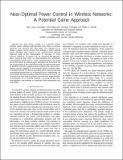Near-Optimal Power Control in Wireless Networks: A Potential Game Approach
Author(s)
Candogan, Utku Ozan; Menache, Ishai; Ozdaglar, Asuman E.; Parrilo, Pablo A.
DownloadOzdaglar_Near-optimal.pdf (156.0Kb)
OPEN_ACCESS_POLICY
Open Access Policy
Creative Commons Attribution-Noncommercial-Share Alike
Terms of use
Metadata
Show full item recordAbstract
We study power control in a multi-cell CDMA wireless system whereby self-interested users share a common spectrum and interfere with each other. Our objective is to design a power control scheme that achieves a (near) optimal power allocation with respect to any predetermined network objective (such as the maximization of sum-rate, or some fairness criterion). To obtain this, we introduce the potential-game approach that relies on approximating the underlying noncooperative game with a "close" potential game, for which prices that induce an optimal power allocation can be derived. We use the proximity of the original game with the approximate game to establish through Lyapunov-based analysis that natural user-update schemes (applied to the original game) converge within a neighborhood of the desired operating point, thereby inducing near-optimal performance in a dynamical sense. Additionally, we demonstrate through simulations that the actual performance can in practice be very close to optimal, even when the approximation is inaccurate. As a concrete example, we focus on the sum-rate objective, and evaluate our approach both theoretically and empirically.
Date issued
2010-05Department
Massachusetts Institute of Technology. Department of Electrical Engineering and Computer Science; Massachusetts Institute of Technology. Laboratory for Information and Decision SystemsJournal
2010 Proceedings IEEE INFOCOM
Publisher
Institute of Electrical and Electronics Engineers
Citation
Candogan, Utku Ozan et al. “Near-Optimal Power Control In Wireless Networks: A Potential Game Approach.” INFOCOM, 2010 Proceedings IEEE. 2010. 1-9.
Version: Author's final manuscript
Other identifiers
INSPEC Accession Number: 11291648
ISBN
978-1-4244-5836-3
ISSN
0743-166X